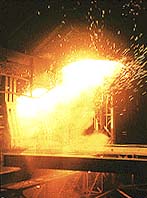| |
Algeria: Introduction
Land & Resources •
People •
Economic Activity •
Government
History •
Current News •
Bibliography •
Quick Facts •
Links
ECONOMIC ACTIVITY
| | |
| |

Algerian horsemen |
|
| |
Algeria's economy has undergone a series of transformations. During the colonial period, when the Algerian economy was tied to France, wines and citrus fruits were major exports. The discovery of petroleum and natural gas in the mid-1950s offered multiple economic opportunities. The socialist government of independent Algeria chose to create a centralized, state-controlled economy; foreign enterprises were nationalized, including French oil and gas interests (1971). In the 1970s, planners concentrated on developing heavy industry but neglected agriculture and social services. The five-year plans of the 1980s sought to correct these imbalances by promoting liberalization, privatization, and foreign investment. Plunging world oil prices in 1986, however, producing a deep recession compounded by rising inflation, government corruption, and a large foreign debt contributed to the October 1988 riots. The subsequent turmoil triggered by the cancellation of 1992 elections which Islamists appeared to have won later threatened the entire economy as armed politicized Islamist groups targeted foreigners, teachers, skilled workers, and infrastructure. Sabotage caused an estimated $1 billion in damage in 1994 alone, when the gross national product declined by 8%. Hopes for an end to the violence and a resumption of foreign investment increased after voters overwhelmingly approved a referendum on a government peace plan in 1999.
Mining and Industry
Petroleum and natural gas are Algeria's most valuable economic assets. Its petrochemical and gas liquefaction facilities are among the world's most modern. Phosphates and iron ore are important exports, although the huge steel complex at Annaba has never operated at full capacity. Lead is also mined. Vehicles, textiles, and cement are leading industries. Algeria generated 19.9 billion kWh of electricity in 1994.
Agriculture
Rapid population growth, the failure of the socialist Agrarian Revolution of the 1970s, and the general subordination of the agricultural sector have forced Algeria to import most of its food, including about 80% of its grain. Free markets and privatization are now encouraged to raise food production and reduce unemployment. Citrus fruits, vegetables, olives, figs, tobacco, and dates are important commercial crops. Wine remains a major export, although vineyards have been uprooted to plant cereal and conform to the Muslim prohibition on the consumption of alcoholic beverages. Livestock raising (cattle, goats, and sheep) is particularly important in semiarid areas. The country became self-sufficient in poultry production in the 1980s, and there are significant sardine and anchovy fisheries.
| | |

With a GDP of $52 billion, Algeria is the second largest economy in Africa (after South Africa). After over 30 years of central planning, proliferation of public sector companies, Algeria has made significant strides in liberalizing its economy.
|
|
|
| |
Transportation and Trade
The impressive colonial infrastructure has been generally maintained or renovated. The expansion of the rail network includes the construction of a subway for Algiers. The excellent road system features a trans-Saharan highway connecting northern Algeria with the far south. Air Algérie is the national airline. With major ports at Algiers, Oran, Arzew, Skikda, and Annaba, Algeria operates a fleet of tankers and trans-Mediterranean ferries.
Although France remains a major trading partner, Algeria has successfully diversified its markets. Petroleum and natural gas account for more than 95% of Algeria's export revenues. By the turn of the century, Algeria had become the world's third largest exporter of natural gas (after Russia and Canada) and the second-largest exporter of liquified natural gas (after Indonesia). It is the largest non-European supplier of natural gas to Europe and the chief supplier of liquified natural gas to the United States.
GOVERNMENT
The National Liberation Front (FLN from its French name) that led Algeria to independence was the country's only legal political party until 1989, when multipartyism was legalized. In January 1992, however, the army seized control. Presidential powers were assumed by a five-member High Committee of State (HCS); an advisory body, the National Consultative Council, was established in 1992. The HCS dissolved itself in January 1994 after selecting a new president to oversee a transition back to democracy; an appointed interim legislature was installed in May. Algeria's first multiparty presidential elections were held in 1995. A multiparty constitution approved by voters in 1996 gives the president, who is limited to two terms, an effective veto over the legislature. Parties based on religion, language, or region are banned. Members of the lower house of the legislature (the National Assembly) are directly elected; two-thirds of the members of the upper house (the Council of the Nation) are indirectly elected, and the rest are appointed by the president.
Next page >> HISTORY
Algeria: Introduction
Land & Resources •
People •
Economic Activity •
Government
History •
Current News •
Bibliography •
Quick Facts •
Links
|
|




